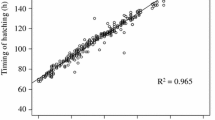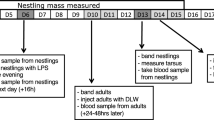Abstract
The peak load reduction hypothesis suggests that hatching asynchrony in altricial birds is adaptive because it reduces parental workload during the most energetically costly time in brood rearing. By staggering the ages of their offspring, parents may ensure that all nestlings do not reach maximum energy demand simultaneously. To test the hypothesis, we used the doubly labeled water technique to measure the energy expenditure of green-rumped parrotlets (Forpus passerinus) that reared experimentally manipulated synchronous and asynchronous broods. Peak metabolic rates of the two experimental groups did not differ, but parents of asynchronous broods metabolized significantly less energy than did parents of synchronous broods throughout the first half of the brood-rearing period. Our results suggest that hatching asynchrony in parrotlets substantially shortens the temporal duration of high brood energy demand, but does not reduce the magnitude of peak energy demand.
Similar content being viewed by others
Author information
Authors and Affiliations
Additional information
Received: 16 July 1998 / Accepted after revision: 13 December 1998
Rights and permissions
About this article
Cite this article
Siegel, R., Weathers, W. & Beissinger, S. Hatching asynchrony reduces the duration, not the magnitude, of peak load in breeding green-rumped parrotlets (Forpus passerinus). Behav Ecol Sociobiol 45, 444–450 (1999). https://doi.org/10.1007/s002650050583
Issue Date:
DOI: https://doi.org/10.1007/s002650050583




